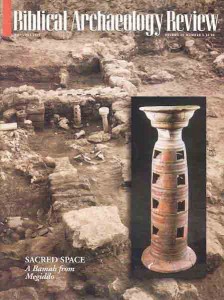
When is a high place not a high place? When it’s a bamah. Victims of an early imprecise translation, the bamot (the plural of bamah) of ancient Canaan and Israel still often appear in our Bibles as “high places,” but they were frequently much more than that, including open-air cultic sites, sacrificial altars and temples. In “What’s a Bamah?—How Sacred Space Functioned in Ancient Israel,” Beth Alpert Nakhai surveys the archaeological evidence for bamot to define the term more expansively and to clarify their role in ancient Israelite religion.
Nakhai earned her Ph.D. in Biblical archaeology from the University of Arizona in 1993 with her dissertation on “Sacred Places in Canaan and Israel: The View from Archaeology.” Since 1985, she has co-directed the Tell el-Wawiyat excavation in Israel’s lower Galilee, on which she has published several papers. As a student, Nakhai also worked as an illustrator and cartographer for numerous excavations in Israel. She has contributed several articles to the forthcoming Encyclopedia of Near Eastern Archaeology (Oxford).
Already a library member? Log in here.
Institution user? Log in with your IP address.

